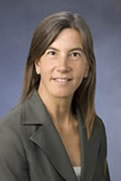With maps, researcher aims to bridge gap between scientists, indigenous experts
LAWRENCE — As humankind wrestles with the growing repercussions of a changing climate, the transfer of knowledge between scientists and local environmental experts becomes ever more crucial to human adaptation.
Yet, due to historical and cultural factors, dialogue about environmental change between two crucial groups — scientists from the developed world and experts from indigenous populations — remains largely ineffective.
"There are indigenous ways of knowing and strategizing about environmental change," said Margaret Pearce, assistant professor of geography at the University of Kansas. "Those are different from nonindigenous people. They're different because they're based on disparate worldviews. It can be as basic as the separation between science and religion, or perceptions of time and ways to measure distance. These kinds of differences then influence the failure of dialogue between indigenous and nonindigenous experts regarding environmental change. It's a very entrenched historical and cultural lack of communication."
Now, using cartography as a tool, Pearce is set to help blend local, indigenous knowledge and outside, scientific understanding of environmental adaptation into a visual entity clear to both groups. Her work is based on recent research conducted in the North Pare Mountains of Tanzania as part of a collaborative study titled "Linking Local Knowledge" funded by the National Science Foundation.
By interpreting the conclusions of previous NSF researchers and communicating with people in the Tanzanian villages of Kirya, Lambo, and Mangio — communities that have suffered a crisis of livelihood loss as the result of environmental change — Pearce will use her training in cartography to translate these findings into maps that visually connect the adaptive strategies of the culturally disparate groups.
"There's a need for a synthesizing dialogue between local and outside experts," she said. "That's been hard in words — whether the words are spoken or written — for a variety of historical reasons. I see cartography as a very powerful tool because it can visually represent spaces of difference and spaces of agreement. You can point and say, 'Here are the places where we agree and see things similarly, and here are the places where we diverge.'"
Through better cross-cultural communication, Pearce aims to help solve the problem of livelihood loss in the region. Further, she hopes to create a model that will encourage both indigenous and nonindigenous people around the world to share strategies for effective adaptation in the face of severe environmental change.
"My expertise is to listen to what people are telling me about geography in a certain place and represent those geographies graphically in the map," Pearce said. "What's wonderful about cartographic language is that it can show specific information like, 'This is how far we used to have to walk to water, and this is how far we walk now.' But maps can also show differences in how we think in general, like the way we think about distance. A Western scientist might use kilometers to map how far away something is, whereas local people might map the same distance in terms of the time on a watch, because for them the distance is inextricable from time. Those differences can be revealed clearly on the map."
Pearce will devote a full year to this project as an American Council of Learned Societies Fellow and as the Anne Ray Fellow at the School for Advanced Research in Santa Fe, N.M., where she will be based. Pearce's collaborators in the NSF project include researchers at Ohio University, Michigan State University, University of Florida and Sokoine University.
